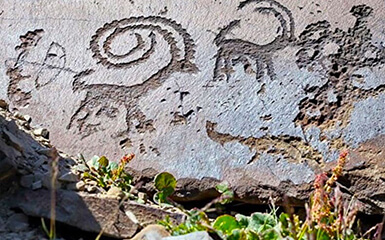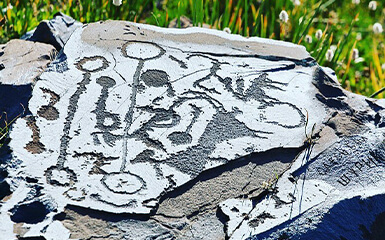Saimaluu Tash (place of patterned stones) is an archaeological site with petroglyphs in Kyrgyzstan. The city was placed on its UNESCO World Heritage List in 2001.
The site is located in the Fergana Mountains, a mountain range of Tian Shan, in the area of Jalalabat about 80 km northeast of the capital Jalalabad and about 30 km southwest of Kazarman, the administrative seat of the Togus-Toro district, at an altitude of 35 meters above eta 3000. The city is divided into two adjacent high valleys, which are separated from each other by a low elevation.
The petroglyphs in Saimaluu Tash are not carvings in rock walls, but loose stones with engraved images gathered here. It is the largest collection of individual stones with petroglyphs worldwide. About 10,000 stones with images were identified. The oldest stones date from the third to early second millennium BC. Chr., D. h. from the Copper Stone Age and the Bronze Age.
The stones most likely represent votive gifts brought from the valleys to these holy places. Among the images are images of wild and domestic animals, birds and humans, geometric symbols and signs, images of faces of deities as well as a series of figures that can not be explained.
Due to the high position of the area, the stones are mostly covered with snow and can only be visited in July / August. Kasarman offers multi-day trekking tours, which are carried out by horse-drawn carriage on foot and by foot on foot.
Kyrgyzstan has acceded to the 1995 World Convention. In 2001, the first six places on the Kyrgyzstan's tentative list were included, one of which was the Saimaluu Tash Petroglyphs.
Saimaluu Tash is remarkable in that it is inhabited by the population of Tian-Shan and Pre-Fergana from the third millennium BC. There has been used as a holy place until the Middle Ages and even to this day. It is thus a rich source of knowledge about the everyday life, the mentality, the history and culture of the ancient tribes of hunters, breeders and first farmers in Central Asia, about the development of their spiritual culture, their religious beliefs and their worship of mountains, Totems and solar-cosmic images.


